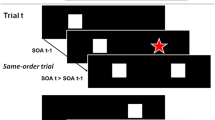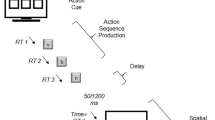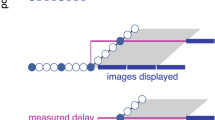Abstract
One of the most remarkable aspects of motor skill is the precision with which actions can be timed. In this chapter we will be concerned with the control of actions whose timing is dictated by how the organism is moving relative to the environment, as in locomotion, or by how an object is moving relative to the organism, as in catching or hitting something. We will refer to this as extrinsic timing. It requires predictive information about the relative motion of the organism and objects and surfaces in the environment, information that is often only available through vision. Time to contact (meaning, in general, time to nearest approach) is a particularly important predictor.
Access this chapter
Tax calculation will be finalised at checkout
Purchases are for personal use only
Preview
Unable to display preview. Download preview PDF.
Similar content being viewed by others
References
Hofsten, C. von. Predictive reaching for moving objects by human infants. Journal of Experimental Child Psychology 30 (1980) 369 – 382.
Alderson, G. J. X., D. J. Sully and H. G. Sully. An operational analysis of a one-handed catching task using high speed photography. Journal of Motor Behavior 6 (1974) 217 – 226.
Sharp, R. H., and H. T. A. Whiting. Exposure and occluded duration effects in a ball-catching skill. Journal of Motor Behavior 6 (1974) 139 – 147.
Smyth, M. M. and A. M. Marriott. Vision and proprioception in simple catching. Journal of Motor Behavior 14 (1982) 143 - 152.
Whiting, H. T. A., E. B. Gill and J. M. Stephenson. Critical time intervals for taking in flight information in a ball catching task. Ergonomics 13 (1970) 265 – 272.
Lee, D. N., J. R. Lishman and J. A. Thomson. Visual regulation of gait in long jumping. Journal of Experimental Psychology: Human Perception and Performance 8 (1982) 448 – 459.
Koenderink, J. J., and A. J. Van Doom. Invariant properties of the motion parallax field due to the movement of rigid bodies relative to an observer. Optica Acta 22 (1975) 773 – 791.
Hofsten, C. von. Catching skills in infancy. Journal of Experimental Psychology: Human Perception and Performance 9 (1983) 75 - 85.
Lee, D. N. The optic flow field: The foundation of vision. Philosophical Transactions of the Royal Society of London B 290 (1980) 169 – 179.
Schiff, W. and M. L. Detwiler. Information used in judging impending collision. Perception 8 (1979) 647 – 658.
Todd, J. T. Visual information about moving objects. Journal of Experimental Psychology: Human Perception and Performance 7 (1981) 795 – 810.
Bower, T. G. R., J. M. Broughton and M. K. Moore. Infant responses to approaching objects: An indicator of response to distal variables. Perceotion and Psychophysics 9 (1970) 193 – 196.
Schiff, W. Perception of impending collision: A study of visually directed avoidant behaviour. Psychological Monographs 79 (1965) whole number 604.
Lee, D. N. Visual information during locomotion. In R. B. McLeod and H. L. Pick (eds), Perception: Essays in Honor of James J. Gibson. ( New York, Cornell University Press, 1974 ).
Lee, D. N., D. S. Young, P. E. Reddish, S. Lough and T. M. H. Clayton. Visual timing in hitting an accelerating ball. Quarterly Journal of Experimental Psychology 35A (1983) 333 – 346.
Lee, D. N., D. S. Young, P. E. Reddish, S. Lough and T. M. H. Clayton. Visual timing in hitting an accelerating ball. Quarterly Journal of Experimental Psychology 35A (1983) 333 – 346.
Miller, S. and G. R. Hammond. Neural control of arm movement in patients following stroke. In M. W. van Hof (ed), Recovery after Damage to Central Nervous System ( New York, Elsevier North-Holland, 1982 ).
McLaughlin, C. M., personal communication (1933).
Lee, D. N., D. S. Young and C. M. McLaughlin. A roadside simulation of road crossing for children. Submitted.
Routledge, D. A., Repetto-Wright, R., and Howarth, C. I. The development of road crossing skill by child pedestrians. In A. S. Hakkert (ed), Proceedings of the International Conference on Pedestrian Safety, vol. 1 ( Haifa, Michlol Technion, 1976 ).
Gibson, J. J. The Perception of the Visual World. ( Boston, Houghton-Mifflin, 1950 ).
Gibson, J. J. Visually controlled locomotion and visual orientation in animals. British Journal of Psychology, 49 (1958), 182 – 194.
Regan, D., and K. I. Beverley. How do we avoid confounding the direction we are looking and the direction we are moving? Science 215 (1982) 194 – 196.
Longuet-Higgins, H. C., and K. Prasdny. The interpretation of a moving retinal image. Proceedings of the Royal Society of London B 208 (1980) 385 – 397.
Prazdny, K. Determining the instantaneous direction of notion from optical flow generated by a curvilinearly moving observer. Computer Graphics and Image Processing 17 (1981) 238 – 248.
Lee, D. N. and P. E. Reddish. Plummeting gannets: a paradigm of ecological optics. Nature 293 (1981) 293 – 294.
Melvill Jones, G. and D. G. D. Watt. Observations on the control of stepping and hopping movements in man. Journal of Physiology 219 (1971) 709 – 727.
Lee, D. N. A theory of visual control of braking based on information about time-to-collision. Perception 5 (1976) 437 – 459.
Warren, W. H. A Biodynamical Basis for Perception and Action in Bipedal Climbing. PhD dissertation, University of Connecticut, 1982.
Author information
Authors and Affiliations
Editor information
Editors and Affiliations
Rights and permissions
Copyright information
© 1985 Martinus Nijhoff Publishers, Dordrecht
About this chapter
Cite this chapter
Lee, D.N., Young, D.S. (1985). Visual Timing of Interceptive Action. In: Ingle, D.J., Jeannerod, M., Lee, D.N. (eds) Brain Mechanisms and Spatial Vision. NATO ASI Series, vol 21. Springer, Dordrecht. https://doi.org/10.1007/978-94-009-5071-9_1
Download citation
DOI: https://doi.org/10.1007/978-94-009-5071-9_1
Publisher Name: Springer, Dordrecht
Print ISBN: 978-94-010-8743-8
Online ISBN: 978-94-009-5071-9
eBook Packages: Springer Book Archive




